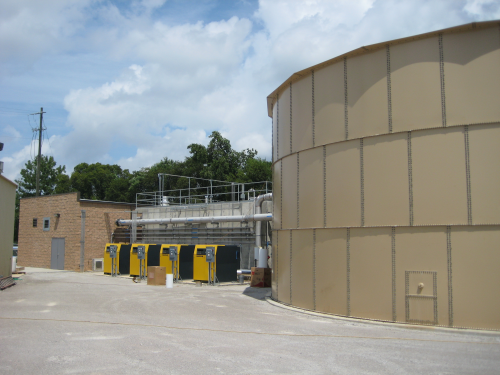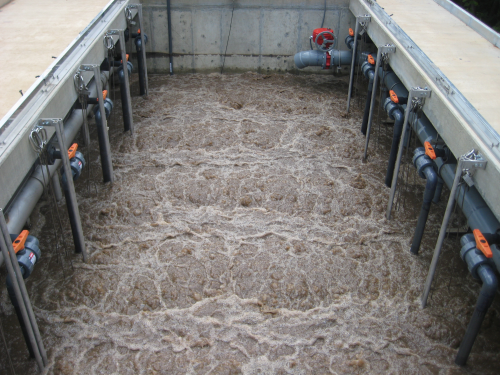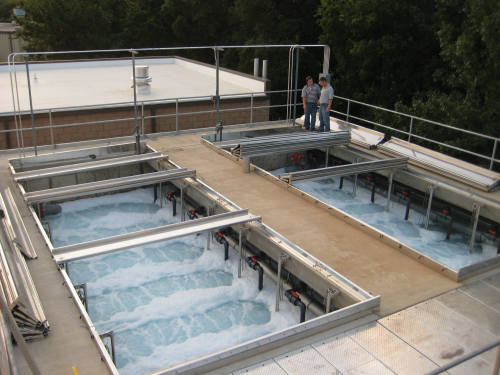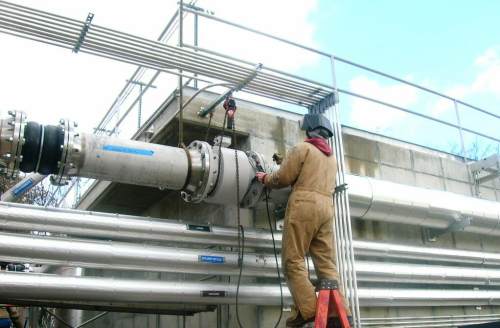



Snack Foods (Golden Flake) located in Birmingham, Alabama, USA was faced with a tough decision, either come up with a solution to stem the escalating municipal wastewater surcharges it was being assessed, or move its 300,000 ft2 (28,000 m2) snack food processing plant out of the county to stem the significantly rising costs. In 1998, the plant was paying $800 to $1,000 per month to Jefferson County in surcharges for decanting its 100,000 to 350,000 gallons per day (379,000 – 1.32 million litres) of wastewater into the county's municipal sewer system. By 2008 that figure had escalated to $100,000 per month in surcharges for the same daily discharged wastewater flow rate, with county projections that the rate would most likely raise to $250,000 per month within the next five years.
Given the fact that 68% of Golden Flake's 250 plus work force lives within a 13 mile radius of the plant, the company preferred to keep it 80 year old headquarters and main manufacturing facility in Birmingham, and find a solution to reduce or eliminate the surcharges. This meant, in essence, getting off of the county sewer system.
The Alabama Department of Environmental Management, which sets standards for wastewater regulations within the state, made it clear that if Golden Flake could reach prescribed TSS (total suspended solids), BOD (biochemical oxygen demand), NH3-N (ammonia-nitrogen) and DO (dissolved oxygen) concentrations, it could receive a discharge permit to convey treated effluent directly into a creek that runs along the perimeter of its property, and bypass the Jefferson County sewer system altogether.
Golden Flake's wastewater
The plant's production mix of potato chips, corn chips and pork skins can vary, causing the raw snack food wastewater to have varying strengths and consistencies, with flow rates ranging from 100,000 to 350,000 gallons per day (gpd).
All of the plant's wastewater handled through its onsite wastewater treatment facility comes from the production of snack foods (no sanitary sewage enters this system), mainly from the processing of potatoes and corn. From their arrival on site, the potatoes are carried in a water flume to be peeled and sliced. The slices are then washed and put through deep fryers before being packaged. The flume and wash water is drained daily and discharged for onsite wastewater treatment.
Raw corn, for the production of corn and tortilla chips, is cooked in kettles with water and lime to loosen and remove the husks, then soaked in vats to increase the moisture content of the kernels. The kernels are then washed to remove impurities, milled, sheeted to run through ovens, deep fried and packaged. The water from these processes is discharged after use for onsite wastewater treatment.
Pork skins arrive at the plant in pellet form and go straight into deep frying, then seasoning and packaging. The plant has seven deep fryers that handle its various product types. The majority of the spent cooking oil is trapped in an oil pit and removed before entering wastewater treatment. But the fryers do need to be boiled-out weekly contributing to the wastewater stream.
Raw snack food wastewater is pumped through vibrating screens which collect 15,000 to 20,000 pounds (6800 - 9100 kg) per week of large food particles. This organic matter is collected and transported upstate to be used as animal feed.
From the time the facility was originally built in the 1950s, the pre-screened wastewater leaving the plant was received at a primary clarifier (for primary sludge settling) with supernatant discharged to the county sewer system (Golden Flake is permitted to release up to 400,000 gallons (1.5 million litres) of wastewater per day). The stagnant wastewater in the primary clarifier was not aerated or covered and would produce off-odours. The clarifier was located along the edge of a street, where subsequently a housing development had been built, and the odour was becoming an issue with residents.
“The wastewater being decanted to the county sewer system had BOD and TSS concentration levels in the thousands, exceeding maximum surcharge levels” says David Jones, executive vice-president of Operations for Golden Flake. “As our surcharges continued to escalate, we began looking for a treatment technology that could not only handle our high-volume peak flows of 350,000 gpd, but also produce an effluent that was below the Alabama Department of Environmental Management's maximum allowable discharge concentration limits for BOD, TSS, NH3-N and DO.”
Engineering a solution
Golden Flake brought in ADI Systems to engineer a solution. The problem was somewhat complicated by the fact that the plant is landlocked in its position, being in the Birmingham inner city. There was no room for site expansion, and little available room for a conventional activated-sludge facility with the footprint requirements for spray fields that would be required to process the plant's wastewater flow.
ADI Systems recommended the implementation of a membrane bioreactor (MBR) system to treat the raw wastewater following the vibrating screens. The ADI-MBR process, based on technology developed by ADI Systems and Kubota Corporation, is a form of activated sludge technology that uses a submerged membrane barrier to perform the liquids/solids separation and reactor biomass retention functions, instead of gravity clarification, which eliminated problems associated with sludge settling and separation.
The MBR process also fits on compact sites while providing consistent, high quality effluent that can be reused in certain applications.
Golden Flake representatives liked the MBR approach as the treated wastewater (effluent) from the MBR system could then be discharged into the Upper Valley Creek, adjacent to the property, no longer requiring the need and expense of discharging wastewater to the county sewer system.
ADI Systems commissioned a 350 gallon (1327 litre) MBR pilot plant onsite at Golden Flake using a small stream of their pre-screened wastewater. The MBR pilot plant operated for three months to demonstrate and evaluate ADI-MBR technology for treating Golden Flake's wastewater.
The MBR pilot study was a success and demonstrated that ADI-MBR technology was easy to operate, could consistently meet the effluent limits, and produce a direct discharge quality effluent while being situated on a site with a compact footprint.
“The technology is really what sold us,” explains Jones. “We toured a couple MBR facilities in Georgia that were using the Kubota submerged-membrane technology, and we were very impressed by what we saw. The quality of the effluent leaving the MBR for discharge into the stream would meet the requirements of the Alabama Department of Environmental Management.”
“The system also fits in to a very compact and small footprint,” continues Jones. “This is what we needed for our site.”
Membrane bioreactor system
The ADI-MBR system provides a near-absolute barrier to suspended solids and allows for operation at higher mixed liquor suspended solids (MLSS) concentrations (typically 10,000 to 18,000 mg/L versus 2,000-5,000 mg/L as in conventional activated sludge systems) resulting in longer solids retention times, less waste sludge production and a much smaller footprint.
The ADI-MBR system at Golden Flake consists of a pre-aeration tank and two membrane basins, each equipped with double-decker submerged membrane units (SMU).
The MBR system is also equipped with aeration blowers, a re-aeration chamber, pumps, instrumentation and controls. The total package includes a control building with a dewatering press/conveyor system, automatic composite samples, laboratory, office and PLC systems.
During operation of the ADI-MBR system, treated effluent is passed through the membranes via a slight suction, and then aerated to meet the DO limit prior to discharge to the adjacent stream. Waste activated sludge is dewatered onsite with a screw press and the sludge cake is removed for disposal.
“Membrane treatment technologies are often employed when higher quality effluents are required,” says Mike McDermaid, project manager for ADI Systems. “Additionally, the ADI-MBR system is ideal when available plant footprint is very limited, and when the wastewater characteristics make conventional gravity settling technologies difficult or ineffective.”
“The ADI-MBR process results in a robust, ultra-compact treatment system, occupying significantly less footprint compared to a conventional activated sludge treatment system,” continues McDermaid. “We felt this would be a very suitable application for Golden Flake.”
The ADI-MBR system at Golden Flake provides a design hydraulic retention time of approximately 1 day, and is designed for a daily influent flow rate of up to 400,000 gpd. The system treats pre-screened wastewater with BOD and TSS concentrations that range from 1000 to 10,000 mg/L and 200 to 12,000 mg/L, respectively.
System implementation
The new ADI-MBR system began construction in February 2009, became operational in August 2009, and consistently produces effluent that is lower than effluent discharge limits set by the Alabama Department of Environmental Management: <2ppm TSS, (<30 ppm TSS limit); <5 ppm BOD, (<10ppm BOD limit); <1 ppm NH3-N (<1.5 ppm NH3-N limit); and >6 ppm DO (>6ppm DO limit).
Up to 250 gallons per minute of clean, high-quality effluent is released into Upper Valley Creek, and serves to enhance the downstream riparian environment by improving the oxygenation of the water flow within the small watercourse.
The final effluent produced by the ADI-MBR system is clean enough to reuse for certain applications, such as site irrigation. The waste activated sludge from the ADI-MBR system is pumped through an onsite dewatering press to reduce the overall sludge volume to 20,000 pounds (9072 kg) per week, which is then trucked upstate for farm fertilization.
“The entire ADI-MBR treatment system is automated,” explains Jones. “Our maintenance supervisor can completely control the whole system from one location in the plant or from his home on a laptop. Every pump and motor can be controlled from the computer screen. This provides a control flexibility we did not have before.”
One of the biggest benefits of the ADI-MBR system is that Golden Flake is no longer discharging primary treated wastewater into the county sewer system, and is no longer paying escalating surcharges for its wastewater discharge. “The ADI-MBR technology has given us excellent results. The effluent quality we are discharging – the effluent is almost crystal clear – has allowed us to completely eliminate our dependence on the county sewer system and the escalating water surcharges we were having to pay each month.”




